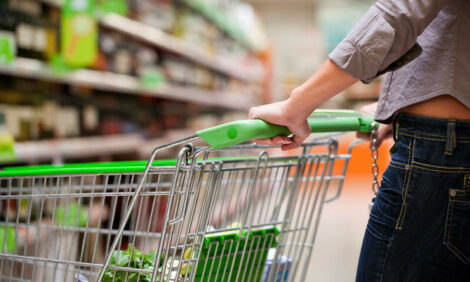



Food firms continue innovating to cut methane emissions
At COP26, 100 nations pledged to cut methane emissions by 30% by 2030In June, LOME, billed as the world’s first low-methane beef, appeared on supermarket shelves in Sweden. It was the outcome of a pilot project by biotech company Volta Greentech, Coop Sweden and food company Protos. The cows had been fed on a food supplement made from red algae, which studies had shown could reduce the methane produce by so-called cow burps by 80%, according to a recent report from Reuters.
For several years seaweed has been touted as a saviour for a beef and dairy sector attempting to get to grips with emissions of methane, a greenhouse gas 80% more potent than carbon. According to the UN Environment Programme (UNEP), 32% of human-driven methane emissions are created by livestock manure and belches, but despite its potency, the gas is short-lived in the atmosphere compared to CO2, which means tackling it now can bring quicker returns.
At COP26, over 100 nations pledged to cut methane emissions by 30% by 2030, and high on their list was addressing the impact of a global cattle population estimated at 1.5 billion.
And with new EU anti-pollution legislation designed to tackle emissions of nitrogen, sulphur and other gases, other countries may follow suit.
Ruaraidh Petre, head of the Global Roundtable for Sustainable Beef, says companies in the beef and dairy industry are are starting to look more closely at their supply chains.
“The EU, UK and Japan, they’re all starting to ask these large corporations to report on Scope 3 emissions,” he says, “(and) if you're going to report on those, you're going to have to know your supply chain pretty intimately.”
Investors want more monitoring and measuring from the biggest producers too, explains Max Boucher, senior manager for research and engagement at the FAIRR Initiative, which works with institutional investors on material issues linked to intensive farming systems.
“There is definitely a push for producers to be very transparent about what’s happening in their supply chains, and for them to set targets to resolve those issues… (with) clear time-bound milestones,” he adds.
Enteric methane in cattle is produced by archaea, a micro-organism in cows’ stomachs that allows them to digest plant fibre. Adding supplements such as seaweed to their diet can inhibit the enzyme that triggers the gas.
However, says Petre, scaling up the production of natural additives such as seaweed to meet demand is a huge undertaking, and artificial alternatives may be a more realistic option. Dutch company DSM, for instance, has developed a supplement that can reduce methane by as much as 90% in beef cattle, and is working with JBS, one of the world’s largest meatpackers, on a trial with 30,000 cattle to find the best way to integrate it into their feed.
Manure is the other great methane producer. While less of a problem with cattle that graze over extended areas, where it becomes a natural fertiliser, it is a serious issue on farms where cows spend much of their time indoors.
Methane digesters can help bring circularity to manure, says Boucher, by turning it into energy. Some digesters go a step further, extracting nutrients such as nitrogen, potash and phosphorus from the dung, and turning them into a natural fertiliser, leaving just a benign organic material that can then be used as a soil improver.
Storing manure in a slurry lagoon can lead to significant emissions of both methane and nitrous oxide, says Petre, but “if you can capture these two very powerful gases, it can dramatically reduce your emission profile.”
How cattle graze can also affect the carbon footprint of beef and dairy farms. The better the grass, the more digestible the diet, explains Petre, and that means fewer emissions. In fact, he says, farms can “easily” cut emissions by 30% by adopting better pasture management, sward composition and more rotational grazing.
Earlier this year, Ben & Jerry’s ice cream launched Mootopia, a project to reduce total greenhouse emissions by 50%, on 15 of its dairy farms in North America and the Netherlands by the end of 2024. The $9.3 million project is funded through parent company Unilever’s Climate and Nature Fund.
Cattle are fed seaweed and have access to high-quality forage, with the farms growing more grass and other feed crops such as nitrogen-fixing leguminous plants, which help to maintain healthy soils, increase carbon sequestration and lower synthetic inputs. Solar panels have also been installed on barns, while methane digesters generate both fertiliser and electricity.
In Mexico, the Margarita programme is part of the Danone Ecosystem Fund and has been working with over 500 small-scale dairy producers for the last 10 years. By introducing regenerative practices such as better water management, reforestation and reduced pesticide use, as well as using more locally sourced food in the cattle’s diet, farms have reduced their carbon emissions by 13%. The dairy farmers have also seen their incomes triple, with Danone now buying 24% of its milk in Mexico from small-scale producers, the company says.
Another solution for beef may be what is known as the complete cycle farm, when a calf spends its entire life in the same place. Generally, cattle that pass through a succession of farms are not as well-managed, and produce far more emissions as a result. The system means better grass too, so that cow grows faster and can be slaughtered sooner.
It can also improve the traceability of the cattle, and help close loopholes, says Petre, with the indirect supply of cattle still a major issue in South America. “It is very hard to trace an individual animal unless you have a national identification system,” he says. “That is a key aspect of a true sustainable beef supply chain: it has to be transparent, and it has to be traceable … retailers need to be able to look into their supply chain.”
Sustainable densification is another option, with more animals per hectare, breeding taking place at a younger age, and slaughter after 18 months, not 30. In this way it takes less time to produce the same amount of meat, while creating less methane.
But Boucher of FAIRR says one of the downsides to this is that a large population of animals in a small space can lead to issues with water quality, so good slurry management is crucial. But the way in which beef and dairy use water is also under scrutiny.
Nearly 90% of beef’s water footprint is from irrigating fodder crops or hay, says Petre. “Feed is highly water intensive,” he concedes, pointing to the western U.S. states, where fodder crops such as maize and alfalfa are grown, and aquifers are running dry. “We need to find much more water- efficient ways of feeding cattle in areas where they’re not just grazing.
“While overhead sprinklers have become the norm and flood irrigation is a thing of the past in water-scarce environments, there are technologies such as subsurface drip irrigation that can radically further improve irrigation efficiency,” he explains.
Dryland crop production, which relies on using moisture stored in the soil, and more drought-tolerant crops, are also being looked at as possible solutions.
In South Africa, several dairy farms that serve Nestle, including the Skimmelkrans Net Zero farm, have computerised soil moisture readers installed on pastures which are irrigated. The probes measure soil moisture at different root depths to maximise water savings.
Alternatives to crops such as soy are also being researched. Candidates include black soldier flies, which are 45% protein and 35% fat, and can be fed on waste from other industries.
But Felipe Villela, founder of ReNature, which supports farmers and companies to scale up regenerative agriculture, isn’t convinced the industry is doing enough to address its environmental impacts. “They're still far away from having truly regenerative beef production, as it demands lots of time, investment and practice in the field. The whole meat sector is moving slowly and not looking at transitioning at scale within their supply-chain but rather just thinking on a pilot mode.”
So is the only way to truly address the impact of livestock on the climate to eat less meat and dairy?
“It’s about diversification and innovation, rather than completely giving up,” says Boucher, but alternative proteins will have a big role to play.
Last year, FAIRR’s Appetite for Disruption: The Last Serving, showed that major food companies were responding to the growing consumer demand for meat and dairy alternatives. Names including Nestle and Unilever are among those to have adopted targets for protein diversification, while investment into “cultivated meat and seafood” topped over $1.4 billion in 2021.
Look at the last raft of reports from the Intergovernmental Panel on Climate Change (IPCC), suggests Boucher, and they’re “very much supportive of increasing the amount of plant-based protein in global diets and decreasing animal protein. (It) gives as one the clearest routes to achieving the Paris agreement goals.”



